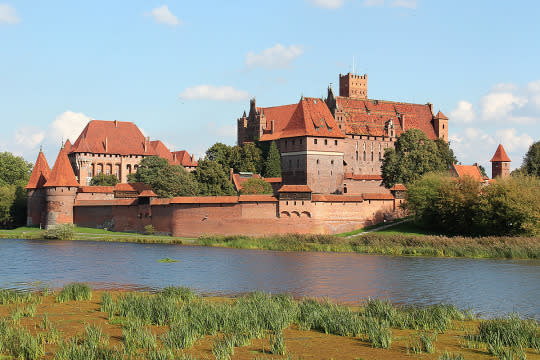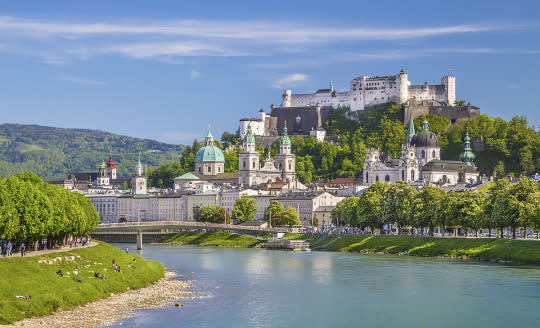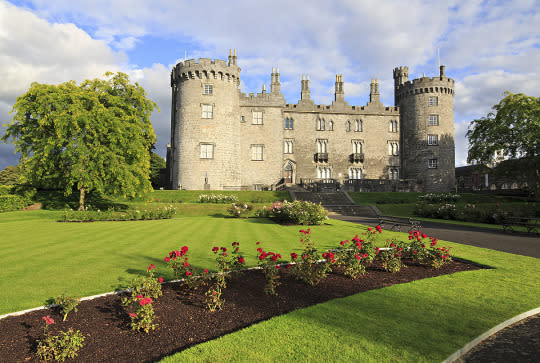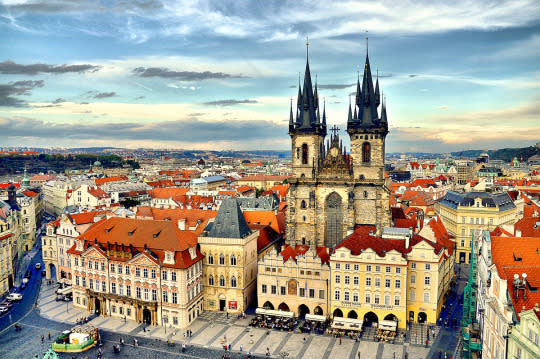Secrets of the World's Most Spectacular Fairy-Tale Castles
Originating in Europe, a castle is an architectural innovation built by nobility throughout the Middle Ages, usually as a private fortified residence.
There are 72 castles on the list of UNESCO World Heritage Sites, some dating back as far as the 9th century, and surprisingly several of these incredible historic buildings are still being used as homes.
Castles come in all different shapes and sizes. With imposing crenelated walls, soaring towers, and dramatic arched entranceways, no two palaces are the same.
But the one thing they all have in common is that they make incredible places to visit.
So whether you are looking for a majestic mountaintop fort, some rustic ruins, or a sprawling manicured country palace, Yahoo Travel has the answer. Here is our list for the most spectacular castles in the world:
1. Neuschwanstein Castle, Germany

The iconic Neuschwanstein Castle (Photo: Thomas Wolf/Wikimedia Commons)
Despite being one of the newest castles on the list, Neuschwanstein Castle in Germany is easily one of the most visually dramatic. This Bavarian beauty is perched on top of a rocky hill overlooking the village of Hohenschwangau and was commissioned in 1869 by King Ludwig the second of Bavaria, using his personal fortune. A true fairy-tale castle, the property is said to have been the inspiration for Disneyland’s Sleeping Beauty Castle. The castle has been open to the public since 1886 and receives over a million visitors a year.
2. Corfe Castle, England

The ruins of Corfe Castle (Photo: iStock)
While the original buildings would have been constructed of wood, the 11th century stone fortress was constructed on the natural hilltop by William the Conquerer and for the next 600 years was used as royal fortress by the British Monarchy. While now in ruin, this captivating site has 1,000 years worth of stories to tell.

Malbork Castle (Photo: Arian Zwegers/Flickr)
The Castle of the Teutonic Order in Malbork is the world’s largest castle by surface area and was built in the 13th century on the banks of the river Nogat by the Teutonic Knights — an order of German Roman Catholic crusaders. It is a classic example of a Medieval fortress and has been listed as a UNESCO World Heritage site since 1997. Used by the knights as a fortified monastery, it has been expanded and restored over the centuries and is now one of Poland’s historic national monuments.
4. Mont Saint-Michel, France

The striking Mont Saint-Michel (Photo: iStock)
Perched high on a small island commune and surrounded by sits the breathtaking Gothic style Benedictine abbey of Saint Michel, whose monastery has occupied the position since the 8th century. The island is situated just 600 meters from the Normandy mainland and linked by a tidal causeway across the sandbanks. At high tide, the water rises up to 14 feet, flooding the surrounding area and completely cutting the island off. Just 50 people live on the island, including the monks, but over 3 million visit the site each year.
5. Hohensalzburg Castle, Austria

Hohensalzburg Castle and the surrounding city (Photo: iStock)
Looming high over the city of Salzburg, this spectacular fortress is one of the largest fortifications in Europe. Construction on the original building began in 1077 but was expanded upon over the next few centuries. In the 16th century, a primitive funicular railway was constructed, providing freight access to the property, and it is still in existence today, making it the oldest operational railroad in the world. In the early 20th century the castle was actually used as a prison, housing Italian POWs during World War I.
Related: Pretend You’re A Princess: Stay in the Most Beautiful Palace and Castle Hotels in the World
6. Kilkenny Castle, Ireland

Kilkenny Castle (Photo: iStock)
This incredible architectural masterpiece was built in 1195 by the first Earl of Pembroke as a stronghold to protect the local town. In 1391, the castle was bought by a prominent local family — the Butlers, who ruled the surrounding area and lived in the home until 1935. That’s over 500 years that the house belonged to one family. During the rest of the last century, the castle was completely restored and opened to the public.
Related: Stay in the Most Lavish Castle in Ireland
7. Alcazar of Segovia, Spain

The Alcazar of Segovia is straight out of a fairy tale (Photo: iStock)
This magical Spanish castle is truly a thing of fairy tales, acting as the inspiration for Disney’s Cinderella castle. Constructed mostly in the 12th century, the structure was home to the monarchs of the Kingdom of Castile and also housed the parliament. After the royal court moved to Madrid at the end of the 16th century, the castle acted as a prison for almost 200 years before being converted into the Royal Artillery School in 1762. Today the property is a heritage site and museum.
8. Prague Castle, Czech Republic

The supremely impressive Prague Castle (Photo: Getty Images)
Prague Castle is arguably the most significant monument in the Czech Republic and according to the Guinness Book of World Records, is the largest castle complex on Earth — at over 70,000m2. The huge collection of palaces and ecclesiastical buildings began their construction back around the 9th century with additions made over the next 500 years. It has been the home of kings, Roman emperors, and most recently the presidents of the Czech Republic. The Bohemian Crown Jewels are also stored within the walls.
Related: Absinthe in Prague: A Drinking Tour Through the Czech Republic
9. Caernarfon Castle, Wales

The ultra dreamy Caernarfon Castle (Photo: Getty Images)
This monstrous stone fortress has been incredibly well preserved and is an excellent example of military architecture erected during the colonization throughout the reign of King Edward I. The first fort on the site was built by the Romans but the main stone structure, most of which is still standing, was constructed at the beginning of the 13th century. It has been a UNESCO World Heritage site since 1986 and now houses the Royal Welch Fusiliers Museum.
10. Kronborg Castle, Denmark

You can even have a fairy-tale wedding at Kronborg Castle (Photo: iStock)
One of the most iconic Renaissance castles in the world, Kronborg Castle was built as a fortress in the early 15th century by King Eric VII to control the entrance to the Baltic Sea. Between 1574 and 1585, Kind Frederic II had the construction dramatically changed into the magnificent palace that stands today. It was used as a Royal residence until 1785 when it became barracks for the army before being opened to the public in the 1920’s. The castle now hosts a very popular renaissance festival, Christmas markets, even weddings.
11. Krak des Chevaliers, Syria

The dramatic Krak des Chevaliers (Photo: Frederic Soltan/Sygma/Corbis)
This almost perfectly preserved crusader castle is arguably one of the most important medieval castles in the world. First inhabited in the 11th century, it was gifted to the Knights Hospitaller by Raymond II, the Count of Tripoli, and was used as a center for administration and as a military base. At its peak, it was home to over 2,000 soldiers and was an impenetrable stronghold in a volatile region. In recent years, it has sadly become inaccessible due to the Syrian Civil War with reports of damage due to shelling occurring in 2012. The castle is listed as a UNESCO World Heritage Site but is registered as one of the 48 world sites ‘in danger.’
Related: When You Can’t Go Home: My Last Visit to Syria Before ISIS
12. Windsor Castle, England

The picturesque Windsor Castle (Photo: Jack Pease/Flickr)
The longest-occupied castle in Europe, Windsor Castle has been a royal residence for the English, and later British monarchy since its construction in the 11th century. First occupied by King Henry I, it is now the preferred weekend residence of the current monarch, Queen Elizabeth II. There are over 500 people who live and work on the property, which is used for state banquets and official royal entertaining. It is also one of the UK’s most popular tourist attractions, receiving hundreds of thousands of visitors a year.
13. Edinburgh Castle, Scotland

The picture-perfect Edinburgh Castle (Photo: Calvin YC/Flickr)
While archeologists can prove human occupation on Castle Rock as far back as the 2nd century, Edinburgh Castle was not built on the hilltop until during the reign of David I, in the 12th century. The castle was a Royal residence from then until 1603, when it became a barracks and garrison. Historians claim there is proof of 26 sieges throughout the castle’s 1,100-year history, making it the “most besieged place in Great Britain.” The castle is now Scotland’s most visited tourist attraction, with over 1.4 million guests a year passing through the gates.
WATCH: How to Vacation Like a Disney Princess
Let Yahoo Travel inspire you every day. Hang out with us on Facebook,Twitter, Instagram, and Pinterest. Check out our original adventure travel series, “A Broad Abroad.”

 Yahoo Finance
Yahoo Finance 